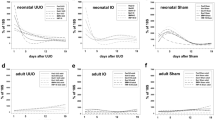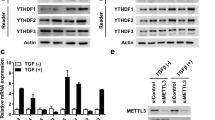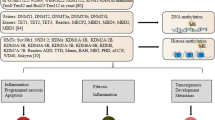Abstract
Background
Urinary tract obstruction is a common cause of renal failure in children and infants, and the pathophysiological mechanisms of obstructive nephropathy are largely unclear. It has been reported that m6A modulation is involved in renal injury. However, whether m6A RNA modulation is associated with obstructive nephropathy has not yet been reported. The aim of this study was to investigate the m6A epitranscriptome profiles in the kidneys of bilateral ureteral obstruction (BUO) in young rats.
Methods
The total level of m6A in the kidneys was measured by liquid chromatography-tandem mass spectrometry. The mRNAs of related genes were detected by real-time PCR. Methylated RNA immunoprecipitation sequencing was performed to map the epitranscriptome-wide m6A profile.
Results
Global m6A levels were increased after BUO, and the mRNA expression levels of m6A methyltransferases and demethylases were significantly decreased in BUO group rat kidneys; the expression levels of EGFR and Brcal were significantly upregulated, while the mRNA expression levels of Notch1 were downregulated (P < 0.05). A total of 154 genes associated with 163 m6A peaks were identified.
Conclusion
The m6A epitranscriptome was significantly altered in BUO rat kidneys, which is potentially implicated in the pathophysiological processes of obstructive nephropathy.
Impact
-
The m6A RNA modification was associated with the process of renal injury in ureteral obstructive nephropathy by participating in multiple dimensions.
-
The dysregulation of m6A methyltransferases and demethylases may be related to the pathophysiological changes of BUO-induced obstructive nephropathy.
-
The m6A RNA modulation of the genes EGFR, Brca1, and Notch1 that were related to the regulation of aquaporin2 might be the potential mechanism for the polyuresis after ureteral obstruction.
Similar content being viewed by others
Log in or create a free account to read this content
Gain free access to this article, as well as selected content from this journal and more on nature.com
or
Data availability
The datasets generated and/or analyzed during the current study are available from the corresponding author on reasonable request.
References
Shimada, K., Matsumoto, F., Kawagoe, M. & Matsui, F. Urological emergency in neonates with congenital hydronephrosis. Int J. Urol. 14, 388–392 (2007).
Ardissino, G. et al. Epidemiology of chronic renal failure in children: data from the ItalKid project. Pediatrics 111, e382–e387 (2003).
Kato, M. & Natarajan, R. Epigenetics and epigenomics in diabetic kidney disease and metabolic memory. Nat. Rev. Nephrol. 15, 327–345 (2019).
Zhou, P., Wu, M., Ye, C., Xu, Q. & Wang, L. Meclofenamic acid promotes cisplatin-induced acute kidney injury by inhibiting fat mass and obesity-associated protein-mediated m6A abrogation in RNA. J. Biol. Chem. 294, 16908–16917 (2019).
Shi, H., Wei, J. & He, C. Where, when, and how: context-dependent functions of RNA methylation writers, readers, and erasers. Mol. Cell 74, 640–650 (2019).
Wei, W., Ji, X., Guo, X. & Ji, S. Regulatory role of N6-methyladenosine (m6A) methylation in RNA processing and human diseases. J. Cell Biochem. 118, 2534–2543 (2017).
Dorn, L. E. et al. The N6-methyladenosine mRNA methylase METTL3 controls cardiac homeostasis and hypertrophy. Circulation 139, 533–545 (2019).
Hubacek, J. A. et al. The FTO gene polymorphism is associated with end-stage renal disease: two large independent case-control studies in a general population. Nephrol. Dial. Transplant. 27, 1030–1035 (2012).
Spoto, B. et al. The fat-mass and obesity-associated gene (FTO) predicts mortality in chronic kidney disease of various severity. Nephrol. Dial. Transplant. 4(Suppl), iv58–iv62 (2012).
Li, X., Fan, X., Yin, X., Liu, H. & Yang, Y. Alteration of N6-methyladenosine epitranscriptome profile in unilateral ureteral obstructive nephropathy. Epigenomics 12, 1157–1173 (2020).
Xu, Y. et al. The N6-methyladenosine mRNA methylase METTL14 promotes renal ischemic reperfusion injury via suppressing YAP1. J. Cell Biochem. 121, 524–533 (2020).
Li, C., Wang, W., Knepper, M. A., Nielsen, S. & Frøkiaer, J. Downregulation of renal aquaporins in response to unilateral ureteral obstruction. Am. J. Physiol. Ren. Physiol. 284, F1066–F1079 (2003).
Feng, J. J. et al. Aquaporin1-3 expression in normal and hydronephrotic kidneys in the human fetus. Pediatr. Res. 86, 595–602 (2019).
Chevalier, R. L. Chronic partial ureteral obstruction and the developing kidney. Pediatr. Radiol. 38(Suppl 1), S35–S40 (2008).
Manucha, W. Biochemical-molecular markers in unilateral ureteral obstruction. Biocell 31, 1–12 (2007).
Hosohata, K., Jin, D., Takai, S. & Iwanaga, K. Vanin-1 in renal pelvic urine reflects kidney injury in a rat model of hydronephrosis. Int. J. Mol. Sci. 19, 3186 (2018).
Devocelle, A. et al. IL-15 prevents renal fibrosis by inhibiting collagen synthesis: a new pathway in chronic kidney disease? Int. J. Mol. Sci. 22, 11698 (2021).
Wei, W., Ji, X., Guo, X. & Ji, S. Regulatory role of N6-methyladenosine (m6A) methylation in RNA processing and human diseases. J. Cell Biochem. 118, 2534–2543 (2017).
Ramalingam, H. et al. A methionine-Mettl3-N6-methyladenosine axis promotes polycystic kidney disease. Cell Metab. 33, 1234–1247.e7 (2021).
Liu, S. et al. METTL3 plays multiple functions in biological processes. Am. J. Cancer Res. 10, 1631–1646 (2020).
Meng, F. et al. METTL3 contributes to renal ischemia-reperfusion injury by regulating Foxd1 methylation. Am. J. Physiol. Ren. Physiol. 319, F839–F847 (2020).
Li, M., Deng, L. & Xu, G. METTL14 promotes glomerular endothelial cell injury and diabetic nephropathy via m6A modification of α-klotho. Mol. Med. 27, 106 (2021).
Franceschini, N. et al. The association of genetic variants of type 2 diabetes with kidney function. Kidney Int. 82, 220–225 (2012).
Chen, G. et al. Association study of genetic variants of 17 diabetes-related genes/loci and cardiovascular risk and diabetic nephropathy in the Chinese She population. J. Diabetes 5, 136–145 (2013).
Wang, J. et al. METTL3/m6A/miRNA-873-5p attenuated oxidative stress and apoptosis in colistin-induced kidney injury by modulating Keap1/Nrf2 pathway. Front. Pharm. 10, 517 (2019).
Wang, J. et al. The biological function of m6A demethylase ALKBH5 and its role in human disease. Cancer Cell Int. 20, 347 (2020).
Zhu, S. & Lu, Y. Dexmedetomidine suppressed the biological behavior of HK-2 cell treated with LPS by down-regulating ALKBH5. Inflammation 43, 2256–2263 (2020).
Zhang, X. et al. ALKBH5 promotes the proliferation of renal cell carcinoma by regulating AURKB expression in an m6A-dependent manner. Ann. Transl. Med. 8, 646 (2020).
Ning, Y. et al. Genistein ameliorates renal fibrosis through regulation Snail via m6A RNA demethylase ALKBH5. Front. Pharm. 11, 579265 (2020).
Mukherjee, M., Fogarty, E., Janga, M. & Surendran, K. Notch signaling in kidney development, maintenance, and disease. Biomolecules 9, 692 (2019).
Mukherjee, M. et al. Endogenous Notch signaling in adult kidneys maintains segment-specific epithelial cell types of the distal tubules and collecting ducts to ensure water homeostasis. J. Am. Soc. Nephrol. 30, 110–126 (2019).
Trepiccione, F., Capasso, G., Nielsen, S. & Christensen, B. M. Evaluation of cellular plasticity in the collecting duct during recovery from lithium-induced nephrogenic diabetes insipidus. Am. J. Physiol. Ren. Physiol. 305, F919–F929 (2013).
Cheung, P. W. et al. EGF receptor inhibition by erlotinib increases aquaporin 2-mediated renal water reabsorption. J. Am. Soc. Nephrol. 27, 3105–3116 (2016).
Lee, Y. J. et al. E3 ubiquitin-protein ligases in rat kidney collecting duct: response to vasopressin stimulation and withdrawal. Am. J. Physiol. Ren. Physiol. 301, F883–F896 (2011).
Mittal, S. & Srinivasan, A. Robotics in pediatric urology: evolution and the future. Urol. Clin. North Am. 48, 113–125 (2021).
Nakano, M., Ondo, K., Takemoto, S., Fukami, T. & Nakajima, M. Methylation of adenosine at the N6position post-transcriptionally regulates hepatic P450s expression. Biochem. Pharm. 171, 113697 (2020).
Chiang, P. K. Conversion of 3T3-L1 fibroblasts to fat cells by an inhibitor of methylation: effect of 3-deazaadenosine. Science 211, 1164–1166 (1981).
Acknowledgements
We would like to thank Keke Ma, who was the administrator of the Laboratory Animal Center of Henan Province for helping us to feed the animals.
Funding
This study was funded by the Medical Science and Technology Research-related joint construction project of Henan Province (7220).
Author information
Authors and Affiliations
Contributions
J.F., Y.Z., J.W., Y.C., J.T., S.Y., Z.Z., B.D., Y.L. and X.Z. made substantial contributions to conception and design, acquisition of data, or analysis and interpretation of data. J.F., Y.Z., J.W., J.T., Y.F. and L.L. made substantial contributions to make animal model. J.F., X.Z., Y.Z., J.W., Y.C. and J.T. drafted the article or revised it critically for important intellectual content. X.Z. made the final approval of the version to be published. J.F., Y.Z., and J.W. made equal contribution to the research.
Corresponding author
Ethics declarations
Competing interests
The authors declare no competing interests.
Ethics approval
All procedures conformed to the Chinese National Guidelines for the Care and Handling of Animals and the published guidelines from the National Institutes of Clinical Medicine, Zhengzhou University, according to the licenses for use of experimental animals issued by the Chinese Ministry of Justice (2022-KY-0046-002).
Consent for publication
The submission of this manuscript for publication is approved by all authors.
Additional information
Publisher’s note Springer Nature remains neutral with regard to jurisdictional claims in published maps and institutional affiliations.
Rights and permissions
Springer Nature or its licensor holds exclusive rights to this article under a publishing agreement with the author(s) or other rightsholder(s); author self-archiving of the accepted manuscript version of this article is solely governed by the terms of such publishing agreement and applicable law.
About this article
Cite this article
Feng, J., Zhang, Y., Wen, J. et al. Alteration of N6-methyladenosine epitranscriptome profiles in bilateral ureteral obstruction-induced obstructive nephropathy in juvenile rats. Pediatr Res 93, 1509–1518 (2023). https://doi.org/10.1038/s41390-022-02228-z
Received:
Revised:
Accepted:
Published:
Issue date:
DOI: https://doi.org/10.1038/s41390-022-02228-z
This article is cited by
-
Characterization of ACTN4 as a novel antiviral target against SARS-CoV-2
Signal Transduction and Targeted Therapy (2024)



